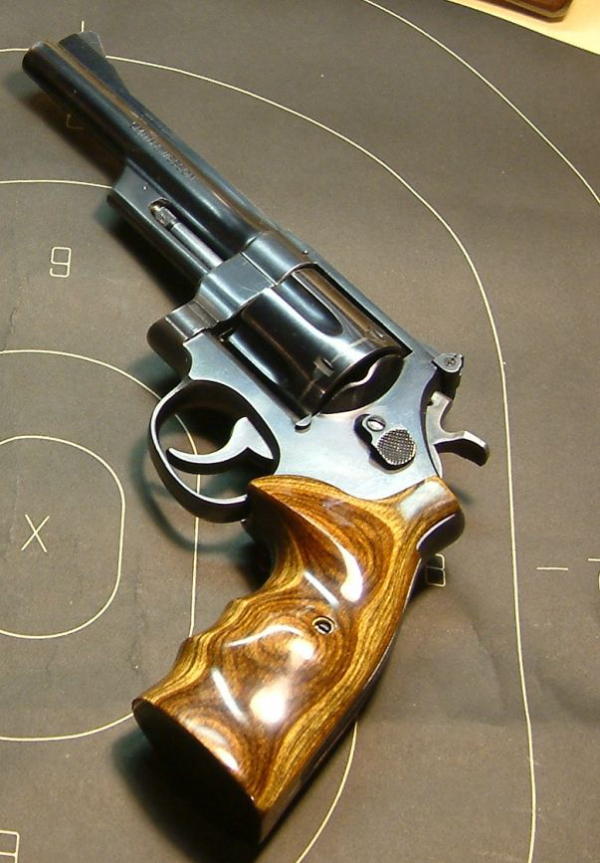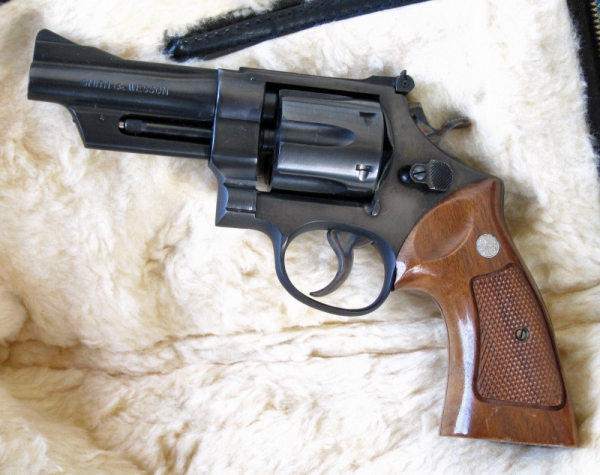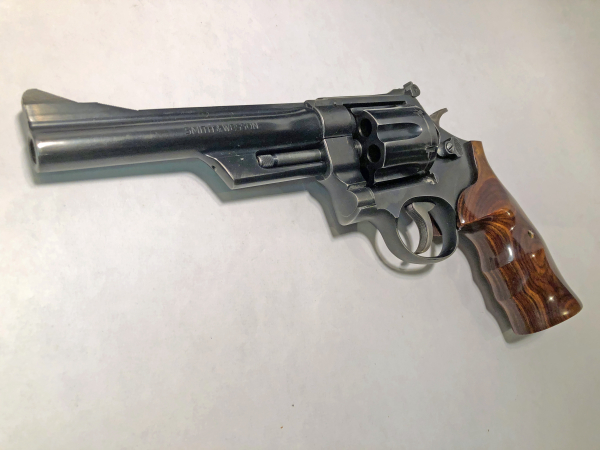
One of the guns of my past was the Smith & Wesson Highway Patrolman.
If you research the line, you’ll see that the HP arose out of the post-war 357 Magnum made by Smith & Wesson, the only company at the time making 357 revolvers. Their history with the cartridge started with its development in the 1930s when produced as the Registered Magnum. A fancy heater built on the 44/45 frame, it was six medium holes bored through a cylinder made to fit the 44 Special, 45 Colt – and, in wartime, the 45 ACP, with moon clips.
This made an immense revolver built to take the chamber pressure of the Magnum round, some three times greater than the 38 Special. The post-war guns were fancy like the prewar pieces, nicely polished, with checkered top straps, a fancy gun.
Too fancy for young cops and agency purchasers, it led S&W in 1954 to cut out the polishing and checkering, making a 357 Magnum they called the Highway Patrolman. An impressive block of steel it was.
Furnished with “Magna” stocks, leaving space between the trigger guard and grip frame, the subdued “frosted blue” of the frame, barrel and cylinder contrasted with the bead-blasted top strap.

It’s hell-for-heavy as it has more steel in the cylinder than the larger caliber versions of the revolver. The barrel gracefully tapers to the muzzle, taking little weight from the package and giving the blue-collar (h/t, Wiley Clapp) cannon a graceful look.
My experience with it? It was humdrum. I didn’t find it particularly easy to shoot, the action didn’t seem to be much about which to write home and I’d even had one converted to an ersatz M25-2 45 ACP revolver.
Fast forward several years and a brother-in-law had become interested in handguns. He’d picked up a Highway Patrolman, I believe Model 28-2, from the local powder-burner’s emporium for retail PLUS. It was a 6” version – the gun was supplied in 4” and 6” barrel lengths. We collected some various 357 Magnum loads and 38 loads and went to shoot it.
I was stunned; I literally couldn’t miss with that huge revolver. It shot better than any M28 of my experience. He would take anything for it, I tried. There was no way he was letting that gun go – even though he wasn’t particularly precise with it. He was new to shooting handguns, so it was a matter of time before he shot up to the HP’s potential.
About a decade later, Mike Rafferty and I were discussing guns we’d let get by us and I told the tale of the super-accurate M28 I’d let get away. He listened with great interest, but he didn’t make any comments I recall.
One fine morning, Mike called me on the radio – I was working the road and he was working downtown. He was heading in and wanted to meet with me. We settled on a convenient parking lot and he handed across a gun rug. Opening it, I found a Model 28 Highway Patrolman. Like most, it was plain and just “okay.”
He said he’d been prowling a small-town gun show and came across the cannon. Looked like, to him, there was a dark spot in the bore. He’d talked the seller down some to a fair deal and bought it.


“You get out to the range more than I do,” he said. “Would you take some assorted ammo out and see if that dark spot is a problem? If it is, I know where I can find a barrel.”
That was a strange request, but I was okay with it. I don’t recall details of the range trip and can’t find my notes, but it seems like it shot well enough. If there was an imperfection in the bore, it certainly didn’t show. I tended to Magnum ammo through the gun. Like all N-frame Smiths, it handled the pressure with no problems.
The finish is thin in places, obvious holster wear near the muzzle and a few storage scratches. It times up fine, the action is not light but solid; deliberate. The single action is firm and clean, no doubt assisting in the accuracy department.
All in all, the gun shot really well. I collected my notes, the gun and rug and took it back to him.
After carefully reading the notes, he said “I really didn’t need it. Why don’t you hang on to it?”
I told him I had plenty of guns, but he wouldn’t hear of it. “Just hang onto it for me,” was all he’d say.
I later traded into a near new M28-2 four-inch. No storage marks except on the stocks, not much of a turn line, it included the receipt from the store where purchased in 1972 – and the box of fifty rounds of S&W ammunition, minus six rounds apparently fired “to make sure it works.”
As to the Rafferty gun, some guns have more value than the work of the maker, the raw materials, the finish, the storage over time. Some just mean a lot because they do. It’s not the artifact, it’s the memories.
I’ve since put some Eagle Grips on that old six-inch HP and not shot it much. But I wouldn’t trade it for anything.
-- Rich Grassi